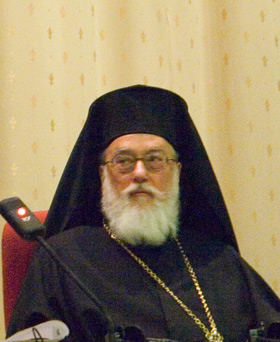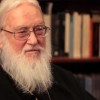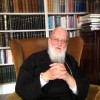Vth International Theological Conference
of the Russian Orthodox Church
ORTHODOX TEACHING ON THE SACRAMENTS OF THE CHURCH
Moscow , 13–16 November 2007
 The patristic foundations of orthodox sacramentology
The patristic foundations of orthodox sacramentology
‘It is the sacraments that constitute the life in Christ’, writes St Nicolas Cabasilas; they are, he says, ‘windows into this dark world’. What, then, are the dominant themes in the Patristic teaching concerning these divine actions, without which there can be no life in Christ? How do the Fathers understand these ‘windows’ that illuminate our existence here on earth?
Let us briefly consider this morning four basic points in the sacramental theology of the Fathers;
First, the meaning of the word ‘sacrament’;
Second, the double nature of a sacrament, both outward and inward;
Third, the minister or agent of every sacrament, namely Christ Himself;
Fourth, the number of the sacraments.
1. The word ‘sacrament’
That which Latin theology terms sacramentum is in Greek theology designated by the word мхуфзсйпн (in Slavonic, tainstvo). The two words have widely differing connotations. The Latin term sacramentum signifies originally the oath of loyalty taken by Roman soldiers, while in legal usage it means a pledge deposited by disputing parties. The Greek term mysterion, on the other hand, has a meaning that is richer and more profound. The word occurs about thirty times in the New Testament, and nowhere there does it signify a liturgical rite. Equally, in the New Testament ‘mystery’ does not mean, as it tends to do in modern usage, simply an unsolved puzzle, a conundrum or enigma. On the contrary, in the proper Scriptural and theological sense, a mystery is something revealed to our understanding, yet never totally and exhaustively revealed, since it reaches out into the infinite depths of God.
In the New Testament, the supreme and fundamental mystery is the Incarnation of Christ. So in Colossians 1. 25–26 St Paul speaks of ‘the mystery that has been hidden throughout the ages and generations’, and that has now been revealed in Christ, who is ‘the hope of glory’. Similarly in Ephesians 1 . 9–10, speaking of the ‘mystery’ of God’s will, Paul says that this is nothing else than the ‘plan for the fullness of time’, to ‘gather up’ or ‘recapitulate’ ( бнбкецблбйщубуибй ) all things in Christ, ‘things in heaven and things on earth’. More particularly this ‘mystery’, previously hidden and now revealed, consists in the uniting of Jews and Gentiles in the one Body of Christ (Ephesians 3. 3–6).
This wide-ranging sense of the term mysterion, whereby it refers to the totality of Christ’s incarnate work, occurs frequently in the early Fathers. It is not until the IIIrd and IVth centuries that the word comes to indicate more narrowly a liturgical rite. Thus, using the term in its broader New Testament sense, St Ignatios of Antioch speaks of the virginity of Mary, her child-bearing and the Lord’s death as ‘three mysteries to be cried aloud ( фсйб мхуфзсйб ксбхгзт ), which were brought to pass in the silence of God’. In similar terms Clement of Alexandria speaks of the ‘manifest mystery’ ( мхуфзсйпн емцбнет ) of the Incarnation, ‘God in man, and man in God’. In the Latin tradition, Tertullian refers to the ‘sacrament of the economy’ (sacramentum oeconomiae), meaning the saving dispensation of Christ Incarnate in its totality; but he also uses the term sacramentum in a more restricted sensed, to signify Baptism and the Eucharist. Long after the term mysterion has acquired the technical sense of a sacramental rite, the Greek Fathers still continue to use it in a more extended and flexible way. When reading them, it is important to allow for this, and not automatically to read back into Patristic texts the more specific understanding of the word ‘sacrament’, as found in modern Roman Catholic and Orthodox theology.
There is a specific reason why this broader sense of the word ‘mystery’ should never be forgotten, and that is the way in which it underlines the essential link between the sacraments and the Incarnation. All sacraments have their source and foundation in the Incarnation of Christ. The ‘mysterial’ actions of the Church are nothing else than the living continuation and the ceaseless extension of the Incarnation through space and time. It is the sacraments that ensure the constant and dynamic presence of the Incarnate Christ within the worshipping People of God. In the words of St Leo the Great, ‘He who was visible as our redeemer has now passed into the sacraments.’ Without the Incarnation there could be no sacraments. Sacramentology is basically a branch of Christology.
The word mysterion has also further resonances and associations. It calls to mind the adjective мхуфйкпт , ‘mystical’, frequently employed by the Fathers in combination with the nouns ‘contemplation’, ‘prayer’, ‘theology’ and ‘union’. The mystical life, as understood by the Fathers, is founded upon the primary mystery of Christ’s Incarnation, and equally it is never to be separated from the sacraments. In this context it is natural to think of Vladimir Lossky’s well-known words: ‘Far from being mutually opposed, theology and mysticism support and complete each other. One is impossible without the other … Mysticism is … the perfecting and crown of all theology: [it is] theology par excellence.’ Surely Lossky’s point may be applied more especially to the sacraments. Sacramental theology and mysticism support and complete each other. The mystical life is impossible without the sacraments. The mystical life is nothing else than the perfecting and crown of our participation in the sacraments. In the words of Myrrha Lot-Borodine, ‘The whole doctrine of mystical illumination is … a supernatural reality inherent in the revelation of Baptism’, and (we may add) inherent in our continuing reception of the Eucharist and the other sacraments.
2. The double nature of sacraments
In the Catechism of the Church of England that I had to learn by heart as a child, a sacrament is defined as ‘an outward and visible sign of an inward and spiritual grace’; a sign, moreover, that is effective, bringing about and causing that which it signifies. This is also the way in which the Fathers understand the nature of a sacrament. Every sacrament has two aspects: outer and inner, visible and invisible. For this reason the Fathers regularly apply to the sacraments the word ‘symbol’, using this term not in a weak but in a strong sense.
Already in the early third century Tertullian clearly indicates the double character of the sacraments: ‘The flesh is washed, that the soul may be made spotless; the flesh is signed [with the cross], that the soul too may be protected; the flesh is overshadowed by the imposition of the hand, that the soul may be illumined by the Spirit; the flesh feeds on the Body and Blood of Christ, so that the soul also may be filled with God. ’Giving to the sacraments an anthropological foundation, St Ambrose of Milan says that their dual character, both visible and invisible, corresponds to man’s two-fold nature, both body and soul; so in Baptism water washes the body, while the soul is cleansed by the Spirit. Developing this same line of thought, St Augustine writes of the Eucharistic bread and wine, ‘They are called sacraments, because one thing is seen in them while another is understood. What is seen has a bodily appearance, but what is understood has spiritual fruit.’
Greek authors speak in closely parallel terms. According to Theodore of Mopsuestia, ‘Every sacrament is the indication, by means of signs and symbols, of invisible and ineffable realities.’ In the words of St Dionysius the Areopagite, ‘The sensible rites ( фб бйуизфб йесб ) are representations of intelligible things, and conduct and guide us to them.’ ‘It is called a sacrament ( мхуфзсйпн ) ,’ writes St John Chrysostom, ‘because what we believe is not the same as what we see, but we see one thing and believe another … When I hear the Body of Christ mentioned, I understand what is said in one sense, the unbeliever in another.’
This double character of the sacraments, both visible and invisible, emphasises with utmost clarity the value, from a Christian standpoint, of material things and more particularly of the human body. As Tertulllain insists in this context, ‘The flesh is the pivot of salvation’ (caro salutis est cardo). For this reason, in the Orthodox Church we seek to preserve undiminished the materiality of the sacramental elements: we insist that Baptism should be by immersion, except in emergencies; at the Eucharist we use leavened bread and red wine; at the funeral rites we keep the coffin open and we kiss the body of the dead person.
The materiality of the sacraments also makes clear the connection, already emphasised, between the ‘mysterial’ actions of the Church and the Incarnation. At His human birth, what the Saviour did was precisely to take material flesh (along with a human soul), and to make of this material flesh a vehicle of the Spirit. So, when we bless water in the sacrament of Baptism, when we bless bread and wine at the Eucharist, and when we bless oil at the Anointing of the Sick, we are likewise transforming these material elements into a vehicle of the Spirit. As well as looking back to the Incarnation, the sacraments equally look forward to, or rather they anticipate, the apocatastasis or final redemption of matter at the Last Day (see Romans 8. 19–23). As Minucius Felix affirms, ‘We are to expect also the spring-time of the body’ (expectandum nobis etiam et corporis ver est). This eschatological spring-time of the body and, more generally, of the entire physical creation is already a present reality in the spiritual materiality of the sacraments.
3. The minister or agent of the sacraments
According to the universal Patristic tradition, both Greek and Latin, the true celebrant at every sacrament is always Christ Himself, invisibly yet effectively present through the Holy Spirit. This is evident from the liturgical praxis of the Orthodox Church. In none of the sacraments does the officiant use the pronoun ‘I’. He says, not ‘I baptise you’, but ‘The servant of God is baptised’; not ‘I ordain you’, but ‘The divine grace, which always heals what is weak and makes up for what is lacking, ordains the devout sub-deacon (name) to be deacon’ (and similarly with the other levels of ordination). As the bishop says to God at the ordination of a deacon, ‘It is not through the laying-on of my hands, but through the visitation of Thy rich mercies, that grace is given to those who are worthy of Thee.’ It is true that Peter Mohila in his Euchologion employs in the sacrament of penance the Latin formula ‘I absolve you’; but this can only be regarded as a deviation from the true sacramental tradition of the Orthodox Church.
This belief in Christ as the true celebrant of all the sacraments is particularly clear in the Divine Liturgy. Before the initial blessing the deacon says to the priest, ‘It is time for the Lord to act’ ( кбйспт фпх рпйзубй фщ Кхсйщ : a quotation from Psalm 118 [119]. 126). The Liturgy, that is to say, is not just words but an action; moreover, it is not primarily our action but the action of the Lord. The true celebrant at every Eucharist is always Christ the unique High Priest; we, the clergy and the people, are no more than concelebrants with him. This same point is explicitly affirmed in the prayer recited by the officiant during the Hymn of the Cherubim, when he says to Christ, ‘Thou art He who offers and He who is offered.’ Christ is both offerer and offering, both sacrificer and sacrifice, both priest and victim. The immediate participation of Christ in the Eucharistic action is expressed also in the greeting exchanged by the clergy during the Kiss of Peace: ‘Christ is in our midst.’
The same understanding of the sacraments as actions of Christ is to be found in the Fathers as well as in the liturgical texts. Thus St Augustine says, ‘Baptism is effective, not by virtue of the merits of those by whom it is administered, nor yet of those on whom it is conferred, but by virtue of its own intrinsic sanctity and truth, because of Him by whom it was instituted.’ Among the Greek Fathers St John Chrysostom is especially definite on this point. ‘It is the Father, the Son and the Holy Spirit who accomplish everything’, he says. ‘The priest merely lends his tongue and supplies his hand.’ At Holy Communion, ‘It is the hand of Christ that is extended to you.’ ‘God’s gifts are not such as to be the result of any virtue of the priest’s; they are wholly the work of grace. The priest’s function is simply to open his mouth, and it is God who accomplishes what is done … The eucharistic oblation remains the same, whether Paul or Peter offers it. The oblation that Christ gave to His disciples is identical with the one now offered by the priests. The latter is in no way inferior to the former, for it is not men who consecrate it, but He who consecrated the original oblation.’
From this it follows that the validity of the sacraments is not hindered by the unworthiness of the celebrant, nor does it depend upon the personal faith of the recipient. On the contrary, as the actions of Christ Himself, the sacraments possess an objective character.
4. The number of the sacraments
Here, as in other areas, proper allowance must be made for the flexible use of the term mysterion in the Fathers. We should not read back into earlier sources the more precise understanding of the seven sacraments to be found in Peter Lombard and the Scholastics from the twelfth century onwards, and subsequently taken over by many Orthodox writers. Moreover, the Greek Fathers do not make a sharp distinction between the sacraments, on the one side, and the other rites of the Church that Roman Catholics describe as ‘sacramentals’.
Many early authors — for example, St Cyril of Jerusalem, St Ambrose, Theodore of Mopsuestia, and St Cyril of Alexandria — think in terms of three primary ‘mysteries’, Baptism, Chrism and Eucharist; but this list of three is not necessarily to be regarded as exhaustive. St Nicolas Cabasilas, in his Life in Christ, emphasises the same three mysteries, but he then goes on to speak of the consecration of the altar as a further ‘mystery’; perhaps, however, this is to be seen as an extension of the sacrament of Chrism. St John of Damascus, on the other hand, thinks in terms of two chief sacraments, Baptism and Eucharist. St Dionysius the Areopagite speaks of six: Baptism, Eucharist, Chrism, Ordination, monastic profession, and the funeral rites; the same list of six is found in St Theodore the Studite. In the second half of the XIIIth century, the monk Job enumerates seven sacraments, but they do not correspond exactly to the Western list; he combines Penance with the Anointing of the Sick, and he then includes monastic profession. He goes on to speak of three other rites: he sees the consecration of a church as the extension of Chrismation, the Great Blessing of the Waters as the extension of Baptism, and the elevation of bread in honour of the Mother of God as the extension of the Eucharist. All of this indicates that Greek Patristic authors, when using the term mystery, are not employing it with the precision found in Latin scholasticism.
It is true that, in the later Byzantine period, there is a tendency to accept the same list of seven sacraments as is found in the West. This is the case, for example, with Manuel Calecas in the XIVth century, and with Joseph Bryennios and St Symeon of Thessaloniki in the XVth. At the Council of Ferrara-Florence (1438–9), the Greeks found no difficulty in accepting the Latin list of seven sacraments. But Joasaph, Metropolitan of Ephesus (also in the XVth century) speaks of as many as ten sacraments. By the XVIIth century, however, the Latin list of seven has become standard in the Orthodox Church: it is followed, for example, by Patriarch Jeremias II, by Gabriel Severus, by Metrophanes Kritopoulos, and by the Synods of Jassy (1642) and Jerusalem (1672). Yet even so this list of seven has never come to possess a strict dogmatic significance in Orthodox teaching, but is adopted primarily as a convenience in teaching. The more flexible usage of the earlier Patristic era has never been entirely forgotten. In any case, when the sacraments are listed as seven in number, it is not to be inferred that these seven stand all upon an equal footing; for there exists a definite ‘hierarchy’ among them, with Baptism and Eucharist occupying a paramount position.
In conclusion, we shall do well to recall the description given earlier of the term ‘mystery’: it is, we said, something revealed to our understanding, yet never completely revealed. This means that there is an apophatic dimension to the Orthodox theology of the sacraments, as there is indeed to all other aspects of theology. We have always to be on our guard against the danger of attempting to say too much. When the Church speaks of the sacraments, she is conscious how large a part of the truth remains necessarily unsaid. In the words of St John Chrysostom, ‘They are said to be mysteries, and such in truth they are; and where there are mysteries, there is need of profound silence’ ( ениб де мхуфзсйб , рпллз уйгз ). ‘The exposition of the divine mysteries’, observes St Cyril of Alexandria , ‘is exceedingly difficult, and perhaps it is better to keep silent.’ Let us hold these warnings before us throughout the present conference.
















